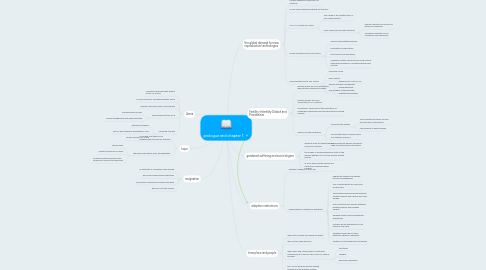
1. Amira
1.1. considered reproductively elderly by her IVF doctor
1.2. an only child from a wealthy Egyptian family
1.3. wanted a big family with a rich husband
1.4. married the first time at 18
1.4.1. marriage lasted 3 years
1.4.2. had four pregnancies she had terminated
1.5. remarried to Emad
1.5.1. petroleum engineer
1.5.2. felt IVF was religiously prohibited in Islam
1.5.3. he was infertile, not Amira
2. hope
2.1. Amira had one viable ovum retrieved and successfully fertilized
2.2. she had complications from the anesthesia
2.2.1. swollen eyes
2.2.2. blisters and bruises on body
2.2.3. received cortisone injection was received to combat the symptoms
3. resignation
3.1. all attempts of conception were missed
3.2. her frozen embryos were destroyed
3.3. her dreams of having a big family had failed
3.4. her life is not truly normal
4. the global demand for new reproductive technologies
4.1. the WHO estimates that 8%-12% of couples experience some form of infertility
4.2. 50-80 million people worldwide are infertile
4.3. 29.4-44.1 million are Muslim
4.3.1. 32% reside in the "infertile belt" of sub-Saharan desert
4.3.2. many cases are secondary infertility
4.3.2.1. primary infertility occurs prior to history of pregnancy
4.3.2.2. secondary infertility occurs following a prior pregnancy
4.4. female infertility due to four factors
4.4.1. sexually transmitted infections
4.4.2. postpartum complications
4.4.3. post-abortive complications
4.4.4. unhygienic health care practices carried out by either the biomedical or traditional health care systems
4.5. male infertility due to four factors
4.5.1. low sperm count
4.5.2. poor motility
4.5.3. defects of sperm morphology
4.5.4. lack of sperm in the ejaculate
5. Fertility-Infertility Dialect and Pronatalism
5.1. women usually do not contracept in high fertility pronatalist societies
5.1.1. exposure to to risk of STD
5.1.2. unsafe abortions
5.1.3. postpartum infections
5.2. infertile women are more susceptible to HIV infection
5.3. pronatalism- beliefs about the importance of motherhood fatherhood and the desirability of having children
5.4. reasons for having children
5.4.1. social security desires
5.4.1.1. secure parent and family survival through labor contributions
5.4.1.2. later support of aging children
5.4.2. social power desire; children serve as a powerful resource
5.4.3. social perpetuity desires; perceived need to continue group structures
6. gendered suffering and social stigma
6.1. infertility leads to mental physical and social suffering
6.2. the burden of suffering generally rests on the woman whether or not if they are the infertile partner
6.3. in some areas infertile women are expected of harming others children.
7. time place and people
7.1. 1986-first ivf center was opened in Egypt
7.2. 1987-first ivf baby was born
7.3. 1988-1989 "free" government ivf treatment introduced but it was not free; costs for citizens included
7.3.1. test tubes
7.3.2. syringes
7.3.3. hormonal medication
7.4. only 15% of the poor women seeking treatment in the program actually entered
8. adoption restrictions
8.1. adoption is against Muslim law
8.2. biased views on adoption by Egyptians
8.2.1. illegitimate children are innately immoral and dangerous
8.2.2. fear of birth parents will come and reclaim child
8.2.3. feeling that emotional affinity between adoptive parents and children will never emerge
8.2.4. erotic attraction will develop between adoptive parents and adopted children
8.2.5. adopted children will be perpetually stigmatized
8.2.6. mothers will be stigmatized for not having a "real child"
8.2.7. adopted children do not have legitimate rights to inheritance
8.2.8. adoption is not available to poor people
